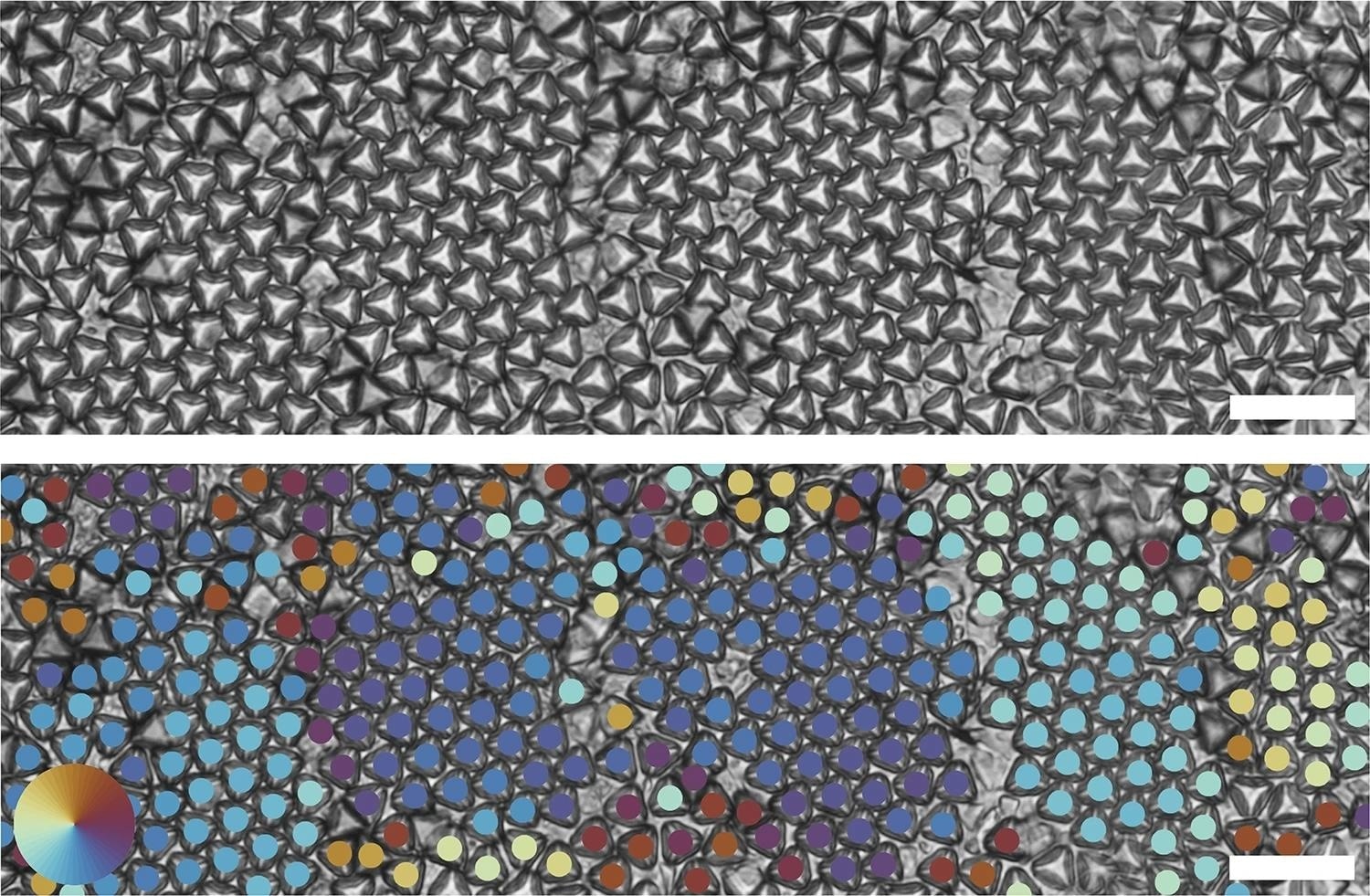Engineers at Stanford have employed 3D printing to create tens of thousands of hard-to-manufacture nanoparticles that have the potential to yield promising new materials that change form in an instant.

Optical images of truncated tetrahedrons forming multiple hexagonal grains (top). Bond order analysis shows different hexagonal grains through different colors (bottom). Neighboring tetrahedrons that have the same color indicate that they have the same grain orientation. Scale bar is 20 µm. Image Credit: David Doan & John Kulikowski
When it comes to nanomaterials, shape is essentially destiny. That is, the geometry of the particle in the material defines the physical characteristics of the resulting material.
A crystal made of nano-ball bearings will arrange themselves differently than a crystal made of nano-dice and these arrangements will produce very different physical properties. We have used a 3D nanoprinting technique to produce one of the most promising shapes known – Archimedean truncated tetrahedrons. They are micron-scale tetrahedrons with the tips lopped off.
Wendy Gu, Assistant Professor, Department of Mechanical Engineering, Stanford University
In their paper, Gu and her collaborators present their method of nanoprinting tens of thousands of intricate nanoparticles, dispersing them into a solution, and observing their self-assembly into diverse, promising crystal structures. Notably, they highlight that these materials possess the remarkable ability to transition between states swiftly, within minutes, by simply rearranging the nanoparticles into new geometric patterns.
The shapeshifting quality, or “phase change,” as materials experts call it, is comparable to the atomic rearrangement that transforms iron into tempered steel or in materials that enable computers to store terabytes of important data digitally.
Gu said, “If we can learn to control these phase shifts in materials made of these Archimedean truncated tetrahedrons it could lead in many promising engineering directions.”
Elusive Prey
Although Archimedean Truncated Tetrahedrons (ATTs) are thought to be among the best geometries for creating materials that may change phases quickly, they were difficult to make until recently. Although they could be anticipated by computer simulations, they were hard to replicate in the actual world.
While Gu and her team are not the first to create large quantities of nanoscale Archimedean truncated tetrahedrons, they are among the first, if not the first, to do it using 3D nanoprinting.
With 3D nanoprinting, we can make almost any shape we want. We can control the particle shape very carefully, and this particular shape has been predicted by simulations to form very interesting structures. When you can pack them together in various ways they produce valuable physical properties.
Wendy Gu, Assistant Professor, Department of Mechanical Engineering, Stanford University
At least two extremely attractive geometric forms are formed using ATTs. The first pattern is hexagonal, with the truncated points of the tetrahedrons pointing skyward like a nanoscale mountain range, while the tetrahedrons lie flat on the substrate. According to Gu, the second one may even be more promising.
The tetrahedrons alternate in upward- and downward-facing orientations within this crystalline quasi-diamond structure, like eggs laid out in an egg carton. Within the photonics world, the diamond arrangement is regarded as the “Holy Grail” and has the potential to open up a wide range of exciting new research avenues.
However, when properly engineered, future materials made of 3D printed particles can be rapidly rearranged, switching easily back and forth between phases with the application of a magnetic field, electric current, heat, or other engineering method.
Gu imagines coatings for solar panels that change during the day to maximize energy efficiency, hydrophobic films for airplane wings and windows that prevent fogging or icing, and new kinds of computer memory, among other applications. The list of possibilities is endless.
“Right now, we are working on making these particles magnetic to control how they behave. The possibilities are only beginning to be explored.” Gu mentioned her ongoing research, which explores innovative applications of Archimedean truncated tetrahedron nanoparticles.
Other Co-Authors of the work are Ph.D. Students David Doan and John Kulikowski. Gu is also a member of Stanford Bio-X.
The research was supported by the National Science Foundation, a Stanford Graduate Fellowship. DD, JK, the Hellman Foundation, and the National Science Foundation. Part of this work was performed at the Stanford Nano Shared Facilities, which is funded by the National Science Foundation, and at the Stanford Cell Sciences Imaging Facility.
Journal Reference:
Doan, D., et al. (2024) Direct observation of phase transitions in truncated tetrahedral microparticles under quasi-2D confinement. Nature Communications. doi.org/10.1038/s41467-024-46230-x
Source: https://www.stanford.edu/